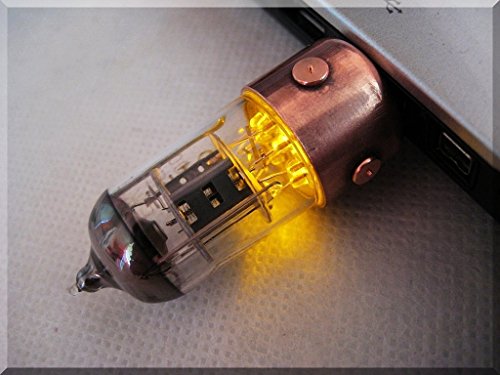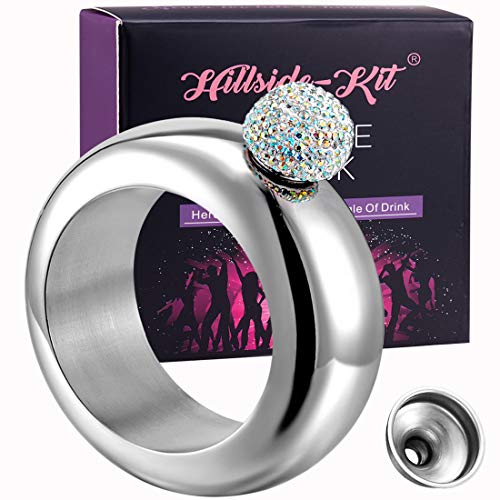
[vc_row equal_height=”yes”][vc_column][vc_row_inner][vc_column_inner width=”1/6″][vc_facebook type=”button_count”][/vc_column_inner][vc_column_inner width=”1/6″][vc_tweetmeme share_via=”YinzBuy”][/vc_column_inner][vc_column_inner width=”1/6″ css=”.vc_custom_1606731333432{margin-top: -5px !important;}”][vc_pinterest][/vc_column_inner][vc_column_inner width=”1/2″][/vc_column_inner][/vc_row_inner][vc_row_inner][vc_column_inner][vc_column_text]Quilting is a wonderful hobby that allows you to create beautiful, yet functional pieces with or without a machine. Using a variety of colored fabrics and threads, you can design patterns that express your personality. In fact, I remember the quilt my mother used to hang on our dining room wall. It added a pop of color, but fit in our farmhouse style just perfectly. However you use them, quilts are incredibly versatile.
If you’re just starting on your quilting journey, you may feel overwhelmed with equipment choices. In fact, there is a large variety of sewing machine options that are well suited to machine quilting. We’ll help you figure out how to choose the best one for your needs.
Once you have the basic tools, you’ll create masterful pieces in no time, so let’s get started![/vc_column_text][vc_column_text]
[/vc_column_text][vc_column_text]
Do You Need A Sewing or Quilting Machine To Quilt?
The straightforward answer is no, you do not need a sewing or quilting machine to quilt. However, this means that you would be doing all your sewing and quilting by hand instead. If you want to finish a project in a shorter period of time, a machine will enable you to do so.
There are various types of sewing machines out there, from basic to complex. Certain options are more geared for quilting versus other types of sewing. In fact, some replicate the stitching so well, it appears to be done by hand! We’ll take a look more specifically at the machines later.[/vc_column_text][vc_column_text]
Straight Line vs. Free Motion Quilting
You’ve probably heard the terms straight line and free motion thrown around. That’s because they are the two most common sewing methods used in quilting. The difference between them lies in the sewing pattern.
A straight line quilting technique involves feeding your fabric through the sewing machine in a straight line. Conversely, the free motion technique is when you move your fabric in any direction that you want as you are sewing.

In many cases, you’ll end up doing both techniques depending on what you’re trying to sew. For example, straight-line quilting works well for when you’re stitching “on the ledge” or “in the ditch,” where you’re trying to secure your fabric by stitching along a certain border. Free motion quilting is best when you’re doing a more decorative design where you would need to move your needle in many directions. Professionals recommend that you complete your straight-line portion before the free motion portion if possible.
Knowing what types of patterns you’d like to create will be integral in choosing a machine. Read on to learn more about what to look for in a quilting machine. [/vc_column_text][vc_column_text]
What Should I Look For In A Quilting Sewing Machine?
There are many different types of sewing machines to choose from, suiting many levels of users. A beginner sewing machine has a basic or limited set of stitching options. As you become more experienced, other sewing machines offer additional and more complex stitching patterns.
If you want to choose one machine to use for a while, it’s important that you evaluate how you want to use your sewing machine beforehand so that you can make a more informed decision when you decide to make your purchase.

In terms of what you should look for in a quilting or sewing machine, there are a few factors. Consider all of the features it can provide, including:
- Ease of operation
- Accessories such as:
- Feet
- Templates
- Frames
- Stitching patterns/options (straight, zigzag, etc)
- Speed (stitches per minute)
- Type of needle threader
- Foot pedal style
- Warranty
Let’s look a little more in depth at the different types of sewing machine options that you have. This will help determine how they operate, so you can pick what’s best for your style. We’ll also dive into some of the features and options, which will help to further narrow your selection.
[/vc_column_text][vc_column_text]
Mechanical
Mechanical sewing machines are usually best for beginners for a variety of reasons:
- They have a limited set of stitches, a less complicated threading method, and are relatively easy to use initially.
- There will be less maintenance required versus a more advanced machine.
- When it comes to cost, they’re usually less expensive. However, you can still find higher-end machines, which give more varied types of stitches.
What makes mechanical sewing machines so valuable for beginners is their ease of operation. Beginning quilters can easily see how small changes affect the overall design without requiring much effort. Mechanical sewing machines allow the users to experiment, easily giving them valuable experience.[/vc_column_text][vc_column_text]
Electronic / Computerized
Electronic sewing machines allow more control and precision than mechanical sewing machines. The needle is controlled through an electronic screen that the sewer can program with specific instructions. Due to the automation, the quality and speed are much better than on other types of machines. However, this also means the machine will be more expensive and require more maintenance. Given the higher price and more complex nature, electronic sewing machines are usually only used by experienced sewers and professionals.
RELATED on YinzBuy:
Are Handmade Gifts Better Than Store Bought? Find Out the Answer!
[/vc_column_text][vc_column_text]
Specialized Sewing Machines
There are other types of sewing machines designed for specialty applications associated with quilting or sewing. These machines will still fall into the electronic or mechanical category, but are set apart from their well-rounded counterparts. If you’re looking to do specific types of sewing or quilting, a specialized machine may be a good fit. I used to use my Serger to finish the ends of homemade pillowcases. Now I wish I had used it to make the squares for a matching quilt!
Here are some examples of specialized sewing machines:
- Embroidering. These computerized embroidery machines create threaded designs, such as logos or monograms. Some options sew as well, but largely they are used to add finishing touches.
- Serging. Also known as an Overlocking machine, these units produce finished edges. You can trim fabric, create seams, and stitch edges easily. They’re a great choice for finishing edges of an easily fraying fabric before use.
- Quilting, including long-arm quilting machines. While these are still sewing machines, they are designed with an extended arm. What this means is that you’ll have a larger work surface on which to sew your quilt.
While a quilting arm machine is great, they also take up a lot of room, given the extended size. This makes them more prominent in commercial settings, or where you have a large, dedicated crafting space. A more broad purpose sewing machine is more common for home use, as it can be used for multiple projects and fits in a smaller area.[/vc_column_text][vc_column_text]
Features and Accessories
A good quilting sewing machine should also have features that will help you with your work. The best features to look for include:
- Built-in needle threader. This threads your sewing needle automatically, preventing eye strain. It makes swapping thread types and colors much quicker.
- Automatic thread trimmer. No need to keep scissors or other cutting tools nearby. This feature of a machine cuts the thread for you when you’re ready.
- Tension Adjustments. Adjust your thread tension in the bobbin or top spool based on the thickness. It keeps thread from bunching, twisting, or dangling loosely.
- Large variety of interchangeable feet. Allows you to quickly change out different types of feet.
- Bright Lighting. Make sure the needle area is well lit, so you can see intricate stitching.
- Speed Control. Increase or decrease the speed of stitching. This is useful as you switch between piecing and quilting.
- Needle Control. Choose a machine with a needle control that you can put up or down at the push of a button. It’s easier to navigate and adjust your fabric, and allows you to go stitch by stitch through tricky parts.
- Feed Dog Flexibility. A machine in which you can drop the feed dogs is ideal. This system normally grabs the fabric for you, pulling it through the machine as you stitch. If they can be dropped down, you’ll have control of the fabric yourself. This is a must for free-stitching.
[/vc_column_text][vc_column_text]
What Type Of Foot Is Needed For Machine Quilting?
In machine quilting, three main types of feet are used on a sewing machine. This is why interchangeable feet are an important option for your unit. Of course, there are many other different types of feet out there. You’ll want to make sure you have at least the industry standards available for your machine.

The three main types of sewing machine feet needed for machine quilting are:
- The Hopping Foot
- The 1/4” Foot (Quilting Foot)
- The Walking Foot
Why is it important to have all these different types of feet? Let’s look a little more at what each one is designed to do.
[/vc_column_text][vc_column_text]
Hopping Foot
The Hopping Foot is used for free-motion quilting. It achieves this by dropping the feed dogs on the sewing machine. In doing so, the machine will no longer feed the fabric for you as you sew. This allows you to move your fabric in any direction to guide the stiches.
This foot will hover above the fabric, and contains a small circular opening that lets the needle move freely. The open design also lets the stitcher see where the needle is going. You’ll need to control your stitch length manually though, since the machine won’t be in control of the feeding.[/vc_column_text][vc_column_text]
The Quarter-Inch Foot
The quarter-Inch foot is mainly used for straight stitching and piecing in quilting. It helps guide the sewer or quilter for straight stitching. It achieves this either by having the user follow the edge of the foot, or by using a built-in guide (if your foot has one). Both variations work the same, but which you choose is personal preference.
The outside edge of the presser-foot is a quarter inch away from the needle itself, which is how the edge of the foot can serve as a reference or guide. This is also why it’s referred to as the 1/4” foot.[/vc_column_text][vc_video link=”https://youtu.be/2ct3G0Nh-pw”][vc_column_text]
The Walking Foot
A walking foot, sometimes called the “even feed foot,” is used for straight stitching, quilting, and piecing. The top foot rotates with the feed dogs on the bottom to feed many layers through the machine at a smooth pace, preventing the layers from shifting.
Many walking feet come with a quilting guide bar, designed exactly for this application. The bar can be adjusted to your desired width. Match up the previous row of stitching with the guide bar as you feed a new row through the sewing machine. This ensures that each row is spaced identically, making for a nice, even quilt.[/vc_column_text][vc_column_text]
Ruler Foot
This isn’t one of the core three feet that you need for machine quilting. However, it’s important to mention anyway. The ruler foot is used with templates, for putting more complicated stitching designs on your quilt. While it’s not necessary to complete a quilt, it is a useful tool to have in your arsenal. You may want to consider if the machine you’re choosing has a ruler foot available, assuming you have a desire to use templates. Check out our section on quilting templates below for a more in-depth look of what they can do for you.[/vc_column_text][vc_column_text]
Can You Quilt Without A Quilting Foot?
It is technically possible to quilt without a quilting foot. However, if you plan to do so, you’re going to need to take other steps to make sure that you still quilt properly. Here are some recommendations for quilting without a quilting foot:
- Drop the feed dogs and manually move your fabric. This allows you to control it better, and make adjustments as needed.
- Choose a larger stitch size. Very small stitches will bunch up your quilt resulting in it not looking as nice.
- Use a foot that’s coated in Teflon or a polished metal. The slippery surface will allow the fabric to move under it much easier.
- Select appropriate fabric. Since you will rely on the natural pressure of the machine, it’s best to use non-slippery fabrics. This will help prevent the layers from shifting or sliding as you sew.
As you can see, there are many considerations needed to quilt without a quilting foot. While this may be trivial for a more experienced quilter, I find it can become overwhelming for a beginner. That is why it is recommended that you quilt with a quilting foot if possible. You’ll achieve a more consistent result, with less manual intervention needed.
 [/vc_column_text][vc_column_text]
[/vc_column_text][vc_column_text]
Stitches Per Minute
Stitches per minute (spm) is a measurement of how fast a sewing machine can stitch your thread. It is calculated by measuring the number of stitches the machine can perform in one minute.
Most household units will max out around just under 1000 stitches per minute However, it is possible to find units that can do a little more. For instance, the Brother PQ1500SL can run up to 1,500 stitches per minute, while the Juki DDL-8100 industrial grade can handle 4,500.
The higher the stitches per minute that your machine has, the faster you’ll be able to stitch your quilt. With straight stitching, you can expect to use a setting of 8-12 stitches per inch. Here’s how long it would take to stitch the outside border of a quilt, based on some common spms:
| SPM | Twin XL | Full | Queen | King |
| 900 | 3.5 minutes | 3.7 minutes | 3.9 minutes | 4.3 minutes |
| 1000 | 3.1 minutes | 3.3 minutes | 3.5 minutes | 3.9 minutes |
| 1500 | 2.1 minutes | 2.2 minutes | 2.3 minutes | 2.6 minutes |
| *Based on standard quilt comforter sizes, which include a 12” overhang over the base mattress dimensions | ||||
| **Using an average assumption of 10 stitches per inch | ||||
As you’ll see, the difference scales based on the size of the piece. Once you factor in the interior stitching (since these times account for only the border) you can expect the gap to increase.
Largely, your needs for stitches per minute will depend on your intended use. If you plan to create lots of large king-sized quilts, investing in a 1,500 spm machine may be worth it. If you want to create one a year as a hobby, then I would recommend getting a more basic spm model.[/vc_column_text][vc_column_text]
Quilting Templates
A quilting template is a guide system that may be used for the overall stitching of your quilt. They are generally made from acrylic material, though paper is available as well. Here are the basic differences between the two types:
Acrylic:
- Pattern is reusable
- Available in a variety of styles
- Have to move the template multiple times during the sewing process
- Doesn’t work with all machines
Paper:
- Won’t have to move the template during sewing
- Works with nearly all machines
- Single use
- Limited styles available
What’s the importance of quilting templates when it comes to machine quilting? In short, it’s understanding the types of templates you prefer, and making sure your machine is compatible. If you want to freehand without a guide or use disposable paper, then it won’t make much difference.
However, if you want the option to use a variety of acrylic templates, you’ll want a machine that can fit them. I don’t know about you, but the last time I tried to freehand anything, it looked like nonsense squiggles. Sign me up for the templates!
Most templates are about 1/4” thick, and you’ll need enough space between your foot and the screw (the base from which you’re sewing on) to insert that. Don’t forget, you’ll also have the thickness of the quilt in that space as well.
Sewing machines come in three varieties: low shank, medium shank, and high shank. The ‘shank’ represents the distance between the foot and the screw. A low shank machine gives you about 3/4” whereas a high shank is 1 1/4”. If you’re using a template, you’ll notice that a low shank machine gives you very little additional room to work.[/vc_column_text][vc_video link=”https://youtu.be/Gt_Y4hkrm6A”][vc_column_text]
Frame System
A frame system for sewing is a type of device that will help hold and secure your fabric. In quilting, it holds the backing, filling, and quilted squares together, keeping the layers secured during stitching. This is incredibly helpful in managing large size pieces, keeping them even and straight.
When it comes to machine quilting, a frame system is optional, but certainly worth considering. As we noted, it can make management of the quilt much easier for sewing. If this is important to you, then you’ll want to ensure that the sewing machine you choose is compatible with a quilt frame.
Quilt frames come in a variety of materials. You’ll most often find them made from metal, plastic, wood, or a combination thereof. Some include rollers for adjusting the visible portion of fabric as you go. The two most common setups for quilt frames are:[/vc_column_text][vc_column_text]
Tabletop
As the name implies, these tabletop machines sit on top of a table. The frame itself moves, while your sewing machine stays stationary.
If you choose a tabletop quilt frame, it will work with most sewing machines since the machine doesn’t have to move. However, you will want to look for a longer throat on your machine. Throat is the distance the top of the unit stretches across. This determines how much space is between the needle and the side of the machine. The larger the throat, the fewer times you’ll have to move your frame to stitch a row. While you can get by with a 3-5” throat, having a unit closer to 7” will make frame use much easier.[/vc_column_text][vc_column_text]
Freestanding
This freestanding frame system stands on its own, replacing a table. The sewing machine sits on a sliding system, moving along the frame rails to sew the quilt. Some options come with the machine as part of the setup. If you’re getting a frame only, you’d need to ensure that the machine you choose would be compatible with it.
Throat size matters here as well, perhaps even more so. With the larger space capabilities of the bigger frame, there will be more exposed fabric to sew. It’s not uncommon to see throat sizes 15” or more on units designed for freestanding quilt frames.
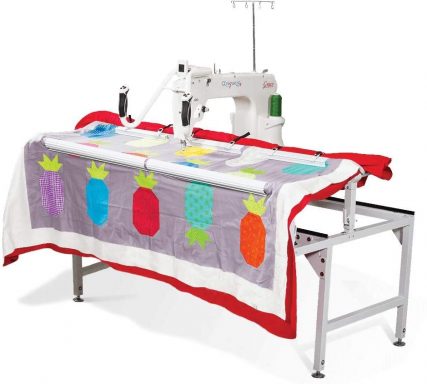
Which of these units you choose largely depends on the space you have available. While the tabletop versions are smaller, they are still generally at least several feet wide. Freestanding units usually take a large portion of the room. If you have a dedicated crafting space, a frame system is a great tool. However, if you’re quilting in a small portion of a larger room, they may not be the best choice.[/vc_column_text][vc_column_text]
What Other Supplies Are Necessary?
Speaking of space considerations, you should factor in some of the other supplies you’ll need for quilting as well. Your choice in machine may be influenced by your workspace area. Some sewing machines even come bundled with other supplies, which can save you money on a package.
Here are some of the most common supplies you’ll want in your quilting area:
- A measuring tool (tape measure/ruler)
- Tailor’s chalk or a fabric pen
- An iron
- Cutting mat to protect your table or countertop
- Straight-edge or cutting guide
- Batting
- Fabric (squares or full bolts)
- Quality scissors or a rotating cutter
- Thread (both bobbin and spools)
- Pins for holding things in place
- Grid tape or a similar product to help prevent tools slipping on fabric
When you’re considering the best sewing machine options for your needs, you’ll be able to factor in the big picture. Make sure your crafting area has space for everything you need, and save time and money by getting it together. I love being efficient!
 [/vc_column_text][vc_column_text]
[/vc_column_text][vc_column_text]
Top Sewing Machine Choices
We’ve discussed a lot of the important elements that go into choosing a sewing machine for your quilting needs. While you have the tools to set out on your own and find the perfect one, we’ve also identified a few great picks.
Here are some top sewing machine choices for machine quilting:
1. Space saving
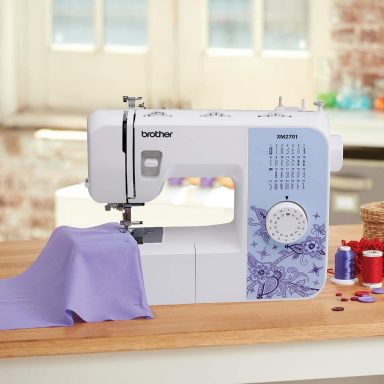
When it comes to small but mighty, the Brother XM2701 is a great pick. It’s a mechanical machine with 27 different stitch choices. It has automatic needle threading, adjustable tensions, and a well-lit work area. Throat length is 5” and it’s a low shank machine. Speed caps out at 800 stitches per minute. The unit measures only 12.1 x 5.9 x 15.3 inches, and weighs just over 12 pounds. Its affordable price tag makes it a great beginner machine if you’re willing to compromise on some features.
2. Best Value

Sewing machines can get quite pricey, let’s face it. If you’re not as concerned about space but don’t want to spend a fortune, check out the Brother XR9550. This electronic machine has 165 different stitches available and an automatic needle threader. A wide, rulered table gives you more space for working and measuring. It has an adjustable speed up to 850 stitches per minute. The throat is about 6” and it’s a low shank machine. An LED light gives you a well-lit space to work. This unit is 13.5 x 20 x 17.9 inches and about 19 pounds. It’s still very affordable, however the bigger unit means more features.
3. Mid-Range Option

This Brother PQ1500SL is the next step above the economy options. This mechanical unit boasts all the same basics as the other models. However, it steps up in stitches per minute, capping out at 1,500. It also has an even wider 21.5” table, giving you more work space for large projects. The throat bumps up to 8.6” for much easier maneuvering. It’s a high shank machine as well, giving you plenty of space for templates and thick quilts. Bonus: it even comes with a walking foot! This is a larger machine at 7.9 x 12.6 x 19.3 inches without the table extension, and weighing 29 pounds. It also only does straight stitching.
4. Premium Option
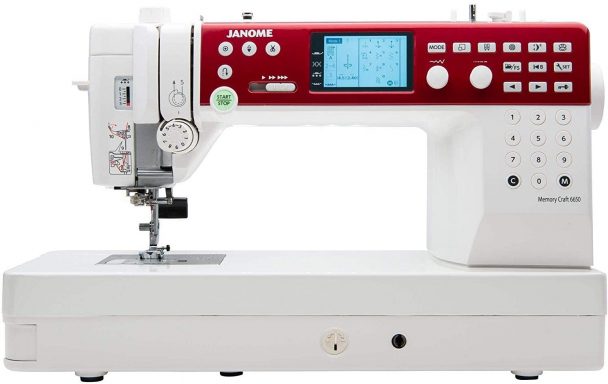
Our last pick is the Janome MC6650 sewing machine. This premium option has a wide deck and all the usual features. So why the increased price tag? Well, this machine has 170 different stitches and a respectable 1,000 spm speed. It has 6 LED lights for one of the best in class lighting setups. An impressive amount of adjustments allow you to customize and have more control. Modify tension, control the needle, and play with the speed. This unit is a professional grade home machine, which has lots of room to grow in skill levels. The 10” throat length is superb for quilting use, and it’s high shank as well. All in all, it’s got an impressive level of options if you want to make the investment.
I’ll note as well that all of these units allow for free motion quilting. Personally, I love the intricate designs on quilts, and I don’t think I’m alone in that one.[/vc_column_text][vc_column_text]
Conclusion
Choosing a sewing machine for quilting can seem like a daunting task. With so many options, you’ve probably felt like you don’t know where to start. Considering your projects, space, and needs will help you narrow it down to a unit that’s perfect for you.
No matter what kind of equipment you end up deciding to use, starting your journey and learning how to sew and machine quilt will definitely be worth your initial investment.
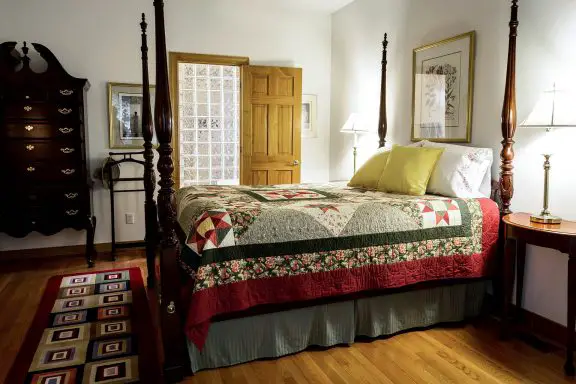
As noted on our Affiliate Disclaimer page, links to products inside this blog could lead to sales commissions (at no additional cost to you) which allow this site to continue operations.
[/vc_column_text][/vc_column_inner][/vc_row_inner][/vc_column][/vc_row]
